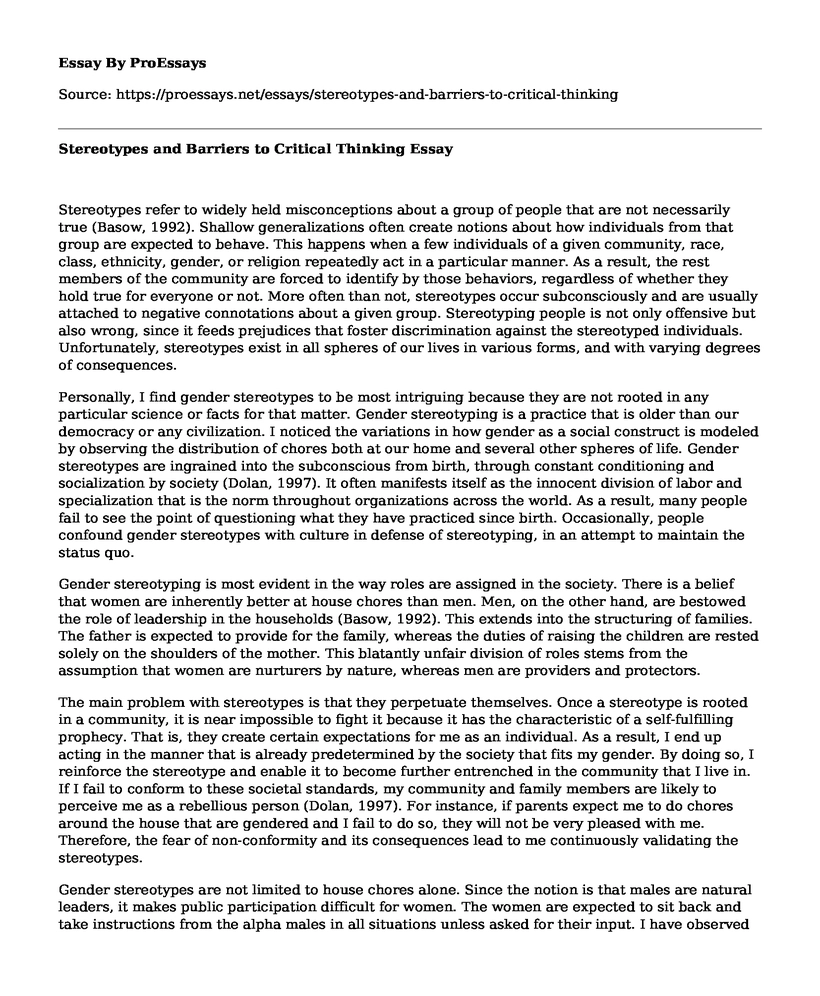Stereotypes refer to widely held misconceptions about a group of people that are not necessarily true (Basow, 1992). Shallow generalizations often create notions about how individuals from that group are expected to behave. This happens when a few individuals of a given community, race, class, ethnicity, gender, or religion repeatedly act in a particular manner. As a result, the rest members of the community are forced to identify by those behaviors, regardless of whether they hold true for everyone or not. More often than not, stereotypes occur subconsciously and are usually attached to negative connotations about a given group. Stereotyping people is not only offensive but also wrong, since it feeds prejudices that foster discrimination against the stereotyped individuals. Unfortunately, stereotypes exist in all spheres of our lives in various forms, and with varying degrees of consequences.
Personally, I find gender stereotypes to be most intriguing because they are not rooted in any particular science or facts for that matter. Gender stereotyping is a practice that is older than our democracy or any civilization. I noticed the variations in how gender as a social construct is modeled by observing the distribution of chores both at our home and several other spheres of life. Gender stereotypes are ingrained into the subconscious from birth, through constant conditioning and socialization by society (Dolan, 1997). It often manifests itself as the innocent division of labor and specialization that is the norm throughout organizations across the world. As a result, many people fail to see the point of questioning what they have practiced since birth. Occasionally, people confound gender stereotypes with culture in defense of stereotyping, in an attempt to maintain the status quo.
Gender stereotyping is most evident in the way roles are assigned in the society. There is a belief that women are inherently better at house chores than men. Men, on the other hand, are bestowed the role of leadership in the households (Basow, 1992). This extends into the structuring of families. The father is expected to provide for the family, whereas the duties of raising the children are rested solely on the shoulders of the mother. This blatantly unfair division of roles stems from the assumption that women are nurturers by nature, whereas men are providers and protectors.
The main problem with stereotypes is that they perpetuate themselves. Once a stereotype is rooted in a community, it is near impossible to fight it because it has the characteristic of a self-fulfilling prophecy. That is, they create certain expectations for me as an individual. As a result, I end up acting in the manner that is already predetermined by the society that fits my gender. By doing so, I reinforce the stereotype and enable it to become further entrenched in the community that I live in. If I fail to conform to these societal standards, my community and family members are likely to perceive me as a rebellious person (Dolan, 1997). For instance, if parents expect me to do chores around the house that are gendered and I fail to do so, they will not be very pleased with me. Therefore, the fear of non-conformity and its consequences lead to me continuously validating the stereotypes.
Gender stereotypes are not limited to house chores alone. Since the notion is that males are natural leaders, it makes public participation difficult for women. The women are expected to sit back and take instructions from the alpha males in all situations unless asked for their input. I have observed this scenario even in simple social gatherings such as group discussions and club meetings. More often than not, male individuals tend to take charge of the meeting even before the selection of officials members. Consequently, most leadership positions are taken up by one gender whereas the rest are reduced to spectators and members. Studies have shown that female speakers get interrupted up to thrice as much as male speakers in public forums (Dolan, 1997). Even when women are experts in their fields, there is still a decent chance that they will have to work harder to gain the confidence of their audiences. This same situation replays itself even at higher positions of power in the society. Whether it is corporate boardrooms or elective areas in public service, the underrepresentation of women can be traced back to the misguided belief that they cannot lead as well as men.
Conclusion
All stereotypes can be combated through education. In this case, education is not limited to classroom knowledge and the school system. Stereotypes thrive in conditions of ignorance. Groups that benefit directly from the dissemination of misinformation might even actively engage in the spread of propaganda. Therefore, it is vital to counter these beliefs by providing correct information to ensure the disillusionment of those who would rather maintain the way things operate at the moment. I always take it as my responsibility to try and educate my friends, classmates, and relatives about the lack of basis for the gender stereotypes and socialization that are rampant in our society.
References
Basow, S. A. (1992). Gender: Stereotypes and roles. Thomson Brooks/Cole Publishing Co.
Dolan, K. (1997). Gender differences in support for women candidates: Is there a glass ceiling in American politics? Women & Politics, 17(2), 27-41.
Cite this page
Stereotypes and Barriers to Critical Thinking. (2022, Apr 07). Retrieved from https://proessays.net/essays/stereotypes-and-barriers-to-critical-thinking
If you are the original author of this essay and no longer wish to have it published on the ProEssays website, please click below to request its removal:
- American Noirs Comparative Essay
- The Effect of Maternal Stress on Prenatal Development - Research Paper
- Clinical and Organizational Problem in Memorial Hospital, Jacksonville Paper Example
- Essay on Service Delivery Models: Standards, Principles, Policies & Constraints
- Essay Sample: The Theme of Power in Richard III
- Essay Example on Woman With Chest Pains Seeks Medical Care: Physical Exam Results
- Essay on Promoting Wellness & Wellbeing in Early Childhood: Identifying Socialisation Influences & Strategies







